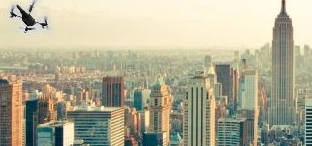US Army Combat Capabilities Development Command (DEVCOM), in partnership with the New York Police Department, undertook a Counter Unmanned Aircraft (CUAS) material experiment in Lower Manhatten dense urban environment in October 2020. A report has now been published to release lessons learned, challenges for deploying CUAS in an urban environment, and equipment performance.
According to a press release by AeroDefense, five equipment vendors were invited to participate. Forty different UAVs were brought to the experiment.
Aerodefense provided its mobile drone capabilities including its RF-based AirWarden system temporary/portable and vehicle-based sensors that operate while in motion. AeroDefense did not know in advance flight paths, launch locations, or the type or number of drones to be flown and only knew the designated protection area. The host agencies used several different drones which varied in size. One was custom built and several were fit with 3D printed boxes to mimic a payload.
Dense urban environments challenge drone detection systems due to heavy Radio Frequency (RF) traffic and large obstructions. Complex structures that cause signal multipath and blockage issues necessitate high placement of equipment and typically cause radar systems to fail. Hardware must be discreet and easily portable as the area of protection can suddenly change in real-world scenarios.
According to a US Army article: “Officers from the New York Police Department Technical Assistance Response Unit flew 49 scripted small unmanned aircraft system trial flights, sometimes with multiple aircraft, and performing a host of intentional maneuvers: shooting straight up and down, scooting low between buildings, buzzing down alley ways and hovering next to courthouse buildings, over the course of two days.”
Antennas mounted on buildings and in vehicles were used to detect, track, identify and classify small unmanned aircraft systems in a dense urban environment. The sensors were designed to find the aircraft using either radar or by detecting the signals that were emitted during communications between the aircraft and their pilots.
Master Sgt. Matthew Gogas, Capability Developer for unmanned systems, 75th Ranger Regiment provided a similar assessment. “The range of RF frequencies and the tall buildings as obstacles provide numerous challenges for this technology to positively identify threats in the area compared to other environments where you’re basically out in an open field.” The challenge created by the various types of urban interference was fully expected. Consequently, the sensor providers did not come to pass, fail, win or lose, but to learn, explained Hesse.
The article quotes Roger Cutitta from the DEVCOM C5ISR Center: “One of the big benefits that was shown here today was the advantage of collaboration of sensors,” He gave an example of a UAV disappearing behind a building. If there was a passive sensor tucked away behind the building and set up to collaborate, it could relay that information so the geo-location of the UAS remained known.
Linda Ziemba, Founder and CEO of AeroDefense, said, “Our AirWarden system, developed in New York metro, has been deployed in a high RF stadium environment since 2018 and had previously proven effective in New York City’s Times Square, so we felt very confident going into the experiment. The AirWarden system’s ability to compete with all the RF noise and operate in motion, coupled with its ruggedized and compact hardware design make it a very unique and practical solution for DUEs.”
Federal, state, and local government agencies can request access to the report by emailing sales@aerodefense.tech
For more information visit:
www.aerodefense.tech




